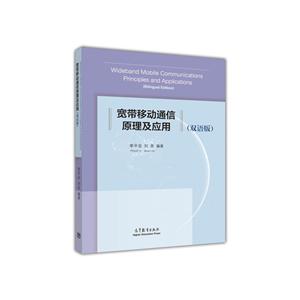宽带移动通信原理及应用-(双语版)
内容简介
[
移动通信目前已发展成为宽带无线通信的主要技 术之一,在4G标准中,许多先进的信号处理和信息传 输技术得到了应用。《宽带移动 通信原理及应用》以英、中双语形式系统地介绍了宽 带移动通信的基本原理及相关应用,主要包括:移动 通信系统介绍、宽带无线信道、数字调制技术、扩频 谱调制和OFDM调制、信道编码、均衡与分集技术、 LTE与LTE—Advanced等。 全书在编写上既注重基础原理的全面性,又能突 出重点,并兼顾了知识的先进性和实用性。部分章节 结合实际系统应用对宽带移动通信新技术进行了介绍 ,如软比特解码、OFDM、OFDMA和SC—FDMA、Turb。 和LDPC编码、MIMO和空时编码、联合的均衡与分集合 并技术、自适应调制与编码等。 本书前半部分为英文内容,后半部分为对应的中 文内容。 本书可用作电子信息类专业及其他相关专业的本 科生和研究生教材,也可供从事研究开发的工程技术 人员参考和借鉴。
]
目录
Chapter 1 Introduction to Mobile Communication Systems1.1 Historical introduction1.2 Cellular concepts1.2.1 Cellular structure and frequency reuse1.2.2 Interference and channel assignment strategies1.2.3 Multiple access techniques1.2.4 Cellular system capacity1.2.5 Roaming and handoff1.3 Trends in mobile wireless communicationsProblemsChapter 2 Wireless Channels in Wideband Transmission2.1 Reflection, diffraction and scattering2.2 Ideal free space propagation2.3 Empirical path-loss models2.3.1 Hata model2.3.2 COST 231 model2.3.3 UMTS30.03 path-loss models2.4 Path-loss Models based on ray tracing2.5 Shadow fading2.6 Multi-path fading2.7 Channel models of wideband wireless systems2.7.1 Doppler spectrum2.7.2 Jakes Model for generating Rayleigh fading coefficients2.7.3 Unit impulse responses of wireless channels2.7.4 Channel modeling2.8 Space-time channel models of wideband wireless systems2.8.1 Basic MIMO models in frequency selective fading channels2.8.2 Models based on antenna correlation matrices2.8.3 Models based on geographical scatter-cluster assumptionProblemsChapter 3 Digital Modulation Techniques3.1 Representation of modulated signals3.2 Signal space analysis3.3 Modulation waveform design3.4 Typical linear modulation techniques3.4.1 BPSK3.4.2 QPSK3.4.3 MPSK3.4.4 16QAM and MQAM3.5 Demodulation and ML decision3.6 BER performance in AWGN3.6.1 Error probability and the union bound3.6.2 Performance in AWGN3.7 Log-Likelihood Ratio(LLR)and soft bit demodulation3.8 Performance in flat Rayleigh fading channel3.8.1 BER of BPSK in fiat Rayleigh fading channel3.8.2 SER of MQAM in flat Rayleigh fading channel3.9 Spectrum efficiency versus energy efficiencyProblemsChapter 4 Spread Spectrum Modulation and OFDM Modulation4.1 DSSS modulation4.2 Spreading codes4.2.1 PN sequences4.2.2 Orthogonal codes4.2.3 CDMA ~4.3 OFDM modulation4.3.1 Principles of OFDM4.3.2 Advantages of OFDM modulation4.3.3 Guard interval and cyclic prefix4.3.4 Signal detection in OFDM systems4.3.5 Disadvantages of OFDM4.4 OFDMA and SC-FDMAProblemsChapter 5 Channel Coding5.1 On Shannon coding theorem5.2 Interleaving5.3 Linear block codes5.3.1 Generic linear block codes5.3.2 Cyclic codes5.4 Low Density Parity Check (LDPC) codes5.4.1 Regular and irregular LDPC codes5.4.2 Constructions of LDPC codes5.4.3 Encoding of LDPC codes5.4.4 Decoding of LDPC codes5.4.5 Elimination of short circles5.5 Convolutional codes5.6 Turbo codes5.6.1 Encoding principles of Turbo codes5.6.2 Decoding of Turbo codes5.6.3 Max-Log-MAP and Log-MAPProblemsChapter 6 Equalization and Diversity6.1 Principles of equalization6.2 Linear equalizers6.3 Block-based linear equalization algorithms6.3.1 Zero-Forcing equalizers6.3.2 MMSE equalizers6.4 Decision feedback equalizers6.5 Diversity6.5.1 Diversity forms6.5.2 Combining techniques6.5.3 Diversity order6.6 RAKE receiverProblemsChapter 7 MIMO Systems and Space-Time Codes7.1 Smart antenna array techniques7.1.1 Principles of the SAA7.1.2 Multi-user SAA techniques in mobile systems7.2 MIMO systems7.2.1 Signal models of MIMO systems7.2.2 Capacity of MIMO systems7.2.3 Spatial diversity7.2.4 Spatial multiplexing7.3 Space-time codes7.3.1 Space-time code design criteria7.3.2 Linear space-time block codes7.3.3 Space-time trellis codes7.4 MIMO-OFDM systems7.4.1 MIMO-OFDM systems with spatial diversity7.4.2 MIMO-OFDM systems with spatial multiplexing7.5 Multi-user MIMO systems7.5.1 Multi-user MIMO-CDMA systems7.5.2 Multi-user MIMO-OFDM systems7.6 Multi-user detection and MU-MIMO7.6.1 Multi-user detection7.6.2 Single-user detection model7.6.3 SU-MIMO and MU-MIMOProblemsChapter 8 Adaptive Modulation and Coding8.1 Principles of AMC8.2 Parameters related to AMC8.2.1 SNR, error rates and throughput8.2.2 Reexamination of spectrum efficiency of MQPSK and MQAM8.3 Threshold determination8.3.1 Threshold determination based on BER or BLER8.3.2 Throughput-based threshold determination8.4 AMC techniques for OFDM systems and MIMO-OFDM systems8.4.1 Individual MCS scheduling for OFDM systems8.4.2 Subband-based AMC for OFDM systems8.4.3 AMC for MIMO-OFDM systems8.5 Combining AMC with HARQ8.5.1 Retransmission types in HARQ8.5.2 AMC in HARQ retransmissionsProblemsChapter 9 LTE and LTE-Advaneed9.1 System architecture evolution9.1.1 Evolved packet core9.1.2 Evolved UMTS terrestrial radio access networks9.2 Physical layer descriptions9.2.1 Frame structure9.2.2 Resource block structure9.3 Logical channels, transport channels, and physical channels9.3.1 Logical channels9.3.2 Transport channels9.3.3 Physical channels9.3.4 Reference signals in the physical layer9.4 LTE transmitting schemes in the baseband9.4.1 Uplink transmitting schemes9.4.2 Downlink transmitting schemes9.5 Detection schemes9.5.1 Uplink detection9.5.2 Downlink detection9.5.3 Timing offset estimation based on DMRS9.5.4 Fractional frequency offset estimation based on DMRS9.6 LTE-Advanced9.6.1 Carrier aggregation9.6.2 Enhanced MIMO techniques9.6.3 Wireless relays9.6.4 CoMP techniques9.6.5 The eICIC-HN techniquesReferences
封面

书名:宽带移动通信原理及应用-(双语版)
作者:李平安
页数:233
定价:¥49.0
出版社:高等教育出版社
出版日期:2016-03-01
ISBN:9787040444797
PDF电子书大小:52MB 高清扫描完整版
